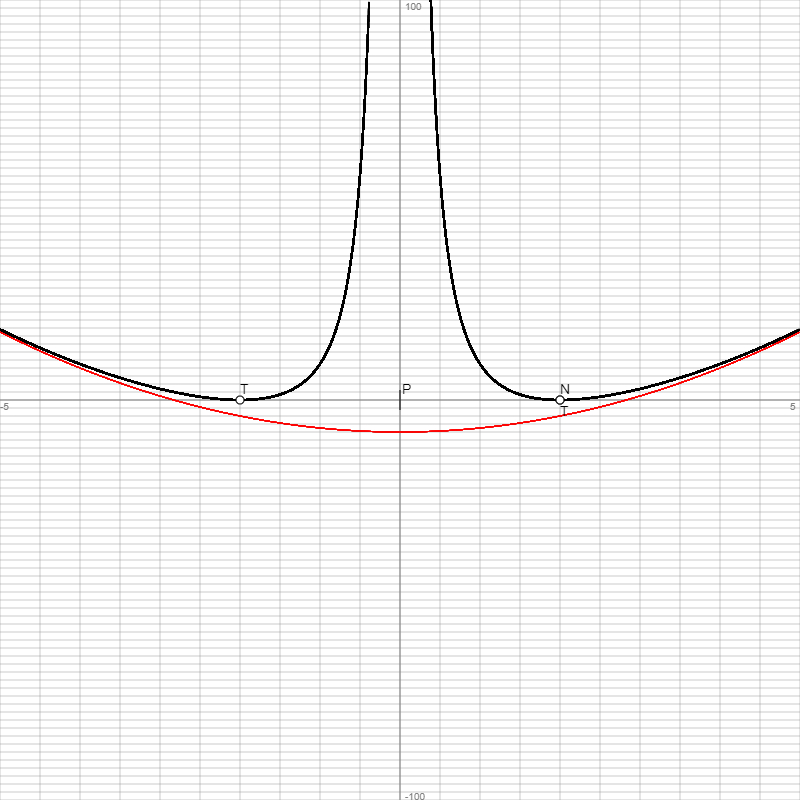 , Df = R\{0}, Wf = [0; +∞), gebrochen rationale Funktion, Funktion achsensymmetrisch zur Senkrechten x = 0, x -> -∞: f(x) -> x2-8 = y als Grenzkurve, x -> +∞: f(x) -> x2-8 = y als Grenzkurve ->
, Df = R\{0}, Wf = [0; +∞), gebrochen rationale Funktion, Funktion achsensymmetrisch zur Senkrechten x = 0, x -> -∞: f(x) -> x2-8 = y als Grenzkurve, x -> +∞: f(x) -> x2-8 = y als Grenzkurve ->www.michael-buhlmann.de
Funktion: f(x) =  , Df = R\{0}, Wf = [0; +∞), gebrochen rationale Funktion, Funktion achsensymmetrisch zur Senkrechten x = 0, x -> -∞: f(x) -> x2-8 = y als Grenzkurve, x -> +∞: f(x) -> x2-8 = y als Grenzkurve ->
, Df = R\{0}, Wf = [0; +∞), gebrochen rationale Funktion, Funktion achsensymmetrisch zur Senkrechten x = 0, x -> -∞: f(x) -> x2-8 = y als Grenzkurve, x -> +∞: f(x) -> x2-8 = y als Grenzkurve ->
| Wertetabelle: | |||||
| x | f(x) | f'(x) | f''(x) | f'''(x) | Besondere Kurvenpunkte |
| -5 | 17.64 | -9.74 | 2.15 | 0.12 | |
| -4.5 | 13.0401 | -8.65 | 2.23 | 0.21 | |
| -4 | 9 | -7.5 | 2.38 | 0.38 | |
| -3.5 | 5.5561 | -6.25 | 2.64 | 0.73 | |
| -3 | 2.7778 | -4.81 | 3.19 | 1.58 | |
| -2.5 | 0.81 | -2.95 | 4.46 | 3.94 | |
| -2 | 0 | 0 | 8 | 12.03 | Nullstelle N(-2|0) = Tiefpunkt T(-2|0) |
| -1.5 | 1.3611 | 6.48 | 20.96 | 50.74 | |
| -1 | 9 | 30 | 98 | 385.93 | |
| -0.5 | 56.25 | 255.01 | 1538.04 | 12412.37 | |
| 0 | Infinity | Infinity | Infinity | Infinity | Senkrechte Asymptote/Pol x = 0 ohne Vorzeichenwechsel: x -> 0-: f(x) -> +∞, x -> 0+: f(x) -> +∞ |
| 0.5 | 56.25 | -255.01 | 1538.04 | -12166.58 | |
| 1 | 9 | -30 | 98 | -382.09 | |
| 1.5 | 1.3611 | -6.48 | 20.96 | -50.4 | |
| 2 | 0 | 0 | 8 | -11.97 | Nullstelle N(2|0) = Tiefpunkt T(2|0) |
| 2.5 | 0.81 | 2.95 | 4.46 | -3.92 | |
| 3 | 2.7778 | 4.81 | 3.19 | -1.58 | |
| 3.5 | 5.5561 | 6.25 | 2.64 | -0.73 | |
| 4 | 9 | 7.5 | 2.38 | -0.37 | |
| 4.5 | 13.0401 | 8.65 | 2.23 | -0.21 | |
| 5 | 17.64 | 9.74 | 2.15 | -0.12 | |
| Graph: | |||||
 | |||||
Graph(en) der Asymptote(n), Grenzkurve(n).
Abkürzungen: Df = (maximaler) Definitionsbereich, f(x) = Funktion, f'(x) = 1. Ableitung, f''(x) = 2. Ableitung, f'''(x) = 3. Ableitung, H = Hochpunkt, L = Lücke, N = Nullstelle, P = Polstelle, R = reelle Zahlen, S = Sprungstelle, T = Tiefpunkt, W = Wendepunkt, WS = Sattelpunkt, Wf = Wertebereich, {.} = ein-/mehrelementige Menge, [.; .] = abgeschlossenes Intervall, (.; .) = offenes Intervall, [.; .), (.; .] = halboffenes Intervall, ∞ = unendlich.
Bearbeiter: Michael Buhlmann